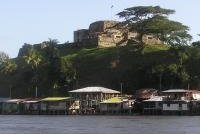Nicaragua
Fortress of the immaculate Conception
Site Info
Official Information
- Full Name
- Fortress of the immaculate Conception (ID: 484)
- Country
- Nicaragua
- Status
-
On tentative list 1995
Site history
History of Fortress of the immaculate Conception
- 1995: Added to Tentative List
- Added to tentative list
- Type
- Mixed
- Criteria
Links
- UNESCO
- whc.unesco.org
All Links
UNESCO.org
- whc.unesco.org — whc.unesco.org
Community Information
- Community Category
- Natural landscape: Forest
- Secular structure: Military and Fortifications
Travel Information
Recent Connections
News
No news.
Recent Visitors
Community Reviews
Show full reviewsSolivagant
Fortress of the immaculate Conception
Fortress of the immaculate Conception (On tentative list)

The Fortress of the Immaculate Conception is better known simply as “El Castillo” after the small village over which it towers, and should be on the “see list” of anyone visiting Nicaragua, both for its own merits (even though it doesn’t seem possible that, at the time of its construction, it could have been the “second biggest fortress” in the entire Spanish American Empire!) and for the scenery of the San Juan River area alongside which it is situated.
The San Juan flows out of Lake Nicaragua into the Caribbean. It is navigable (despite the several rapids) and, historically, was used as a route to enter the lake itself from the sea, including by pirates such as Henry Morgan – indeed the historic city of Granada on the west side of the lake was plundered on several occasions. It was to prevent this that the Fortress was built in 1675. In 1780, the then 21 year old Captain, Horatio Nelson was part of an expedition which captured the fortress as part of an unsuccessful attempt to capture Granada and Leon and thus split the Spanish empire and give access to the Pacific after Spain had joined the anti-British coalition during the American War of Independence. The next time the area surfaced in world history was as part of the route by which people reached California during the 1848-55 gold rush with the steamer service run up the San Juan River by Cornelius Vanderbilt - this led to the river and …
Keep reading 0 comments